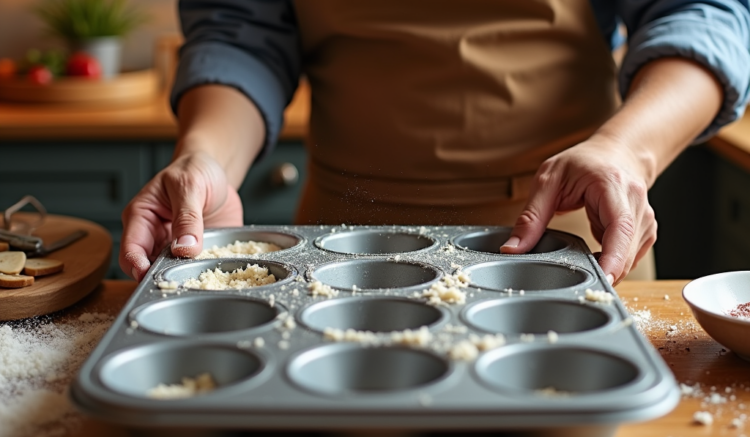If you’ve ever baked muffins or cupcakes, chances are you’ve dealt with the aftermath: a grimy muffin pan. The good news is, you don’t need to resort to harsh chemicals or hours of scrubbing to get your muffin pans looking new again. With a few easy steps and some simple ingredients, you can restore your pans to their former glory. Read on to discover the most effective methods for cleaning your muffin pans without breaking a sweat.
Understanding Why Muffin Pans Get Grimy

Muffin pans often become grimy after multiple uses due to the combination of grease, leftover batter, and heat. The high temperature of the oven can bake these residues into a stubborn layer that’s not easily removed with a simple soapy sponge. Moreover, the non-stick coating or the metal surface of these pans requires gentle handling to prevent damage. Understanding this, it’s essential to adopt cleaning methods that are effective yet gentle enough to maintain the quality and longevity of your bakeware.
Essential Tools and Ingredients

Before embarking on the cleaning process, gather a few common household items. These will not only make your task easier but also spare your muffin pans from any potential damage that harsh chemicals might cause. Here’s what you need:
- Baking Soda
- White Vinegar or Lemon Juice
- A Soft Scrub Brush or Sponge
- Warm Water
- Dish Soap
Each of these items plays a pivotal role in lifting grease, breaking down stubborn residues, and ensuring that you don’t scratch the surface of your muffin pans. Opt for natural ingredients like vinegar or lemon juice for an eco-friendly approach.
Cleaning your muffin pans doesn’t have to be a daunting task. By following a systematic approach, you can ensure every nook and cranny is free from grime.
- First, rinse your muffin pan with warm water to remove any loose residue and pre-soak it for about 10 minutes.
- Mix baking soda with a small amount of water to form a thick paste. This mixture is mildly abrasive and excellent for breaking down tough grime.
- Apply the paste to the grimy areas of the muffin pan, focusing on the cups where residue tends to accumulate. Let it sit for 15–20 minutes.
- Use a soft scrub brush or sponge to gently scrub the paste into the stains, ensuring you don’t damage the surface.
- Rinse thoroughly with warm water to remove all traces of baking soda and grime.
- For any stubborn spots, spray white vinegar or rub a slice of lemon directly on the stains, then rinse again.
By following these steps, you can effectively remove all layers of grime, leaving your pans clean and ready for your next baking adventure.
Preventing Future Build-Up
While cleaning your muffin pans may be straightforward, preventing future grime is even better. First, consider using muffin liners which significantly reduce direct residue contact on the pan. When washing, always do so immediately after use to prevent residues from hardening. Additionally, avoid using metal utensils which can damage the surface, leading to more grime build-up. By implementing these practices, you can significantly extend the cleanliness and lifespan of your muffin pans.
Conclusion
Cleaning grimy muffin pans doesn’t need to be a tedious chore. By utilizing household ingredients and a few mindful techniques, you can easily restore your pans to their shining state. Remember, consistent maintenance and immediate cleaning after baking will minimize grime and prolong your bakeware’s lifespan. With these tips, you can enjoy baking delicious muffins without the hassle of excessive post-bake cleaning.
Frequently Asked Questions
- 1. Can I use a dishwasher to clean muffin pans?
While some muffin pans are labeled dishwasher safe, frequent dishwasher use may cause discoloration and wear down the non-stick coating. It’s advisable to hand wash using the method outlined above. - 2. Is it safe to use steel wool on muffin pans?
No, steel wool can be too abrasive for muffin pans, especially ones with a non-stick coating. Opt for a soft brush or sponge to avoid scratching. - 3. How often should I deep clean my muffin pans?
Deep cleaning should be done every few uses or whenever you notice significant residue buildup. Regular gentle cleaning after each use will reduce the frequency of deep cleanings. - 4. Can I use baking soda and vinegar together?
Yes, but with caution. Baking soda and vinegar react to create a fizzy solution that can help lift grime, but it’s essential to thoroughly rinse afterwards to remove any remaining solution. - 5. What’s the best way to store muffin pans to prevent future grime?
Ensure pans are completely dry before storing them. Stack them carefully and, if possible, place a soft cloth or paper towel between pans to prevent scratching and grime accumulation.
